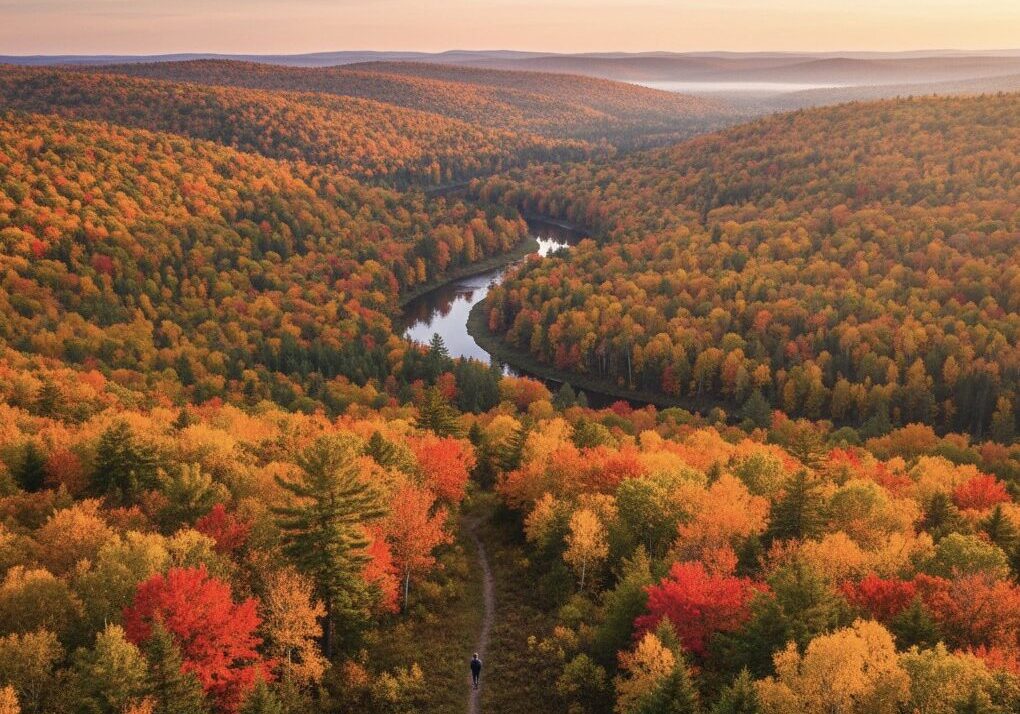The Earth is an ever-changing canvas, but perhaps no transformation is as breathtaking, as vibrant, or as profoundly moving as the annual autumn spectacle in the Northern Hemisphere’s forests. As summer’s green grip loosens, a quiet, chemical-driven revolution takes place, turning swathes of woodland into a technicolor masterpiece that draws millions to its ephemeral glory.
But what turns a sea of summer green into a technicolor masterpiece? The answer lies in a fascinating interplay of botany, chemistry, and climate.
🎨 The Science Behind the Spectacle
Why do the leaves change color? It’s a question as old as time, and the answer is a fascinating lesson in botany and survival.
During the spring and summer, leaves are the plant’s food factories, working tirelessly to convert sunlight into sugars through photosynthesis. The pigment responsible for capturing this light and giving leaves their characteristic green color is chlorophyll. Chlorophyll is so dominant that it masks the presence of other pigments that are already in the leaf:
- Carotenoids: These are responsible for the glorious yellows and oranges you see in maples, birches, and aspens. They are present all summer long but only become visible once the chlorophyll breaks down.
- Anthocyanins: These are the showstoppers, creating the dramatic reds, crimsons, and purples of maples, oaks, and dogwoods. Unlike carotenoids, anthocyanins are produced actively in the fall. They act as a kind of sunscreen, protecting the leaf while the tree efficiently extracts remaining nutrients before shedding it.
As daylight hours shorten and temperatures drop, the tree signals the end of the growing season by creating a separation layer at the base of the leaf stem. This layer effectively cuts off the leaf’s water and nutrient supply, causing the chlorophyll to disintegrate and revealing the hidden palette of yellows and oranges, which are then enhanced by the newly produced reds.
📍 Where the Magic Happens: The North’s Best Stages
While autumn color exists globally, the sheer diversity and density of deciduous trees in the northern temperate zones create the world’s most impressive displays.
- New England, USA: The undisputed champion. States like Vermont, New Hampshire, and Maine offer iconic, rolling landscapes where sugar maples and oaks put on an unparalleled show of reds, golds, and burnt oranges.
- The Canadian Shield: From Ontario to Quebec, the boreal forests mix evergreens with deciduous trees like birch and poplar, creating a stunning contrast between deep pine green and brilliant yellow.
- Kyoto, Japan: A more subtle, spiritual experience. Japanese maples (momiji) are meticulously cultivated for their fiery crimson hues, providing a breathtaking backdrop to ancient temples and Zen gardens.
- Bavaria, Germany: The forests of the Alps and the Black Forest offer a more muted yet expansive landscape of golds and russets, perfect for long hikes.
Timing is everything. The peak color, often referred to as “peak foliage,” typically occurs between late September and mid-October in most northern locations, moving from north to south.
Tips for Maximizing Your Viewing Experience
Consider these tips:
- Plan for Peak: Use local tourism websites to track “peak foliage” forecasts.
- Chase the Light: The colors are most vivid in the early morning and late afternoon when the sun is low on the horizon.
- Look Beyond the Forest: Seek out waterways. The reflections of the colorful trees on the still surface of a lake or river can double the visual impact.
🧘 Why You Should Witness It: A Lesson in Impermanence
Beyond the dazzling visual appeal, witnessing the northern forest’s autumn transformation offers a profound psychological benefit.
This natural cycle provides a powerful, annual reminder of impermanence and renewal. In a world that often demands constant growth and stability, the falling leaves teach us the beauty and necessity of letting go.
Walking through an autumn forest, with the satisfying crunch of leaves underfoot and the crisp, clean scent of decaying matter in the air, forces us to slow down. It encourages mindfulness and reconnection with the natural rhythm of the Earth. It’s an easy way to experience the wild, to find a moment of peace, and to be overwhelmed by an entirely unmanufactured beauty.
It’s more than just a colorful view; it’s an invitation to pause and appreciate one of nature’s greatest, most dramatic artistic expressions before the world settles into the quiet, stark beauty of winter. Don’t let this magnificent masterpiece fade without seeing it for yourself.
🍁#FallColors #Foliage #NorthernForests #TechnicolorMasterpiece 🌍#AutumnTravel 🧘#NatureScience ✨#ChangingCanvas #AutumnSpectacle





